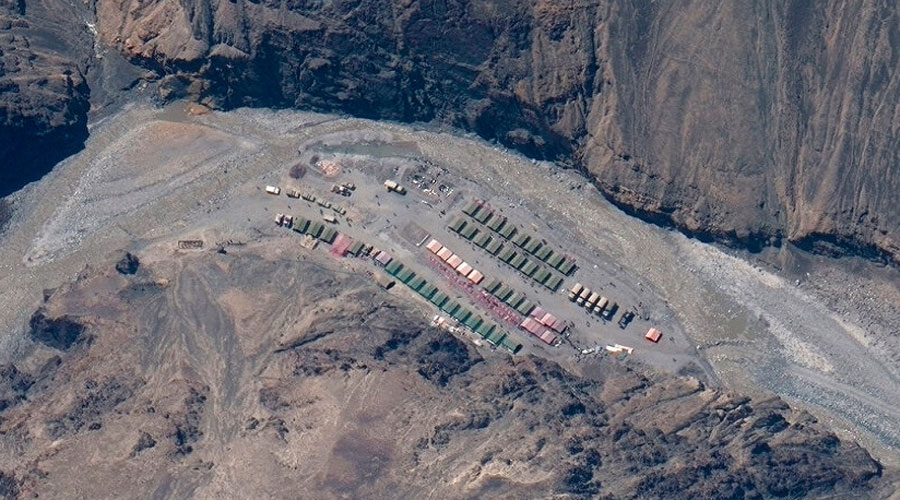
China builds concrete towers with CCTV cameras to watch India: Indian Army has put up wooden poles fitted with digital cameras
Don't Miss
The Indian Army has in a 'tit for tat' put up wooden poles fitted with digital cameras to watch Chinese movements, said sources
Imran Ahmed Siddiqui | TT | 13.07.21: China has erected concrete watchtowers with CCTV cameras atop them inside India-claimed lines in Ladakh to monitor Indian troop deployment, sources in the security establishment told The Telegraph on Monday.
The Indian Army has in a “tit for tat” put up wooden poles fitted with digital cameras to watch Chinese movements, the sources added.
The episode comes at a time military veterans have been saying the Indian government’s serial capitulations on the talks table have emboldened the Chinese to get more aggressive by the day instead of adhering to the terms of the disengagement agreements.
The sources said the Chinese observational posts were among various military structures, including camps, that the People’s Liberation Army was continuing to build at the remaining friction points of Depsang Plains, Hot Springs and Gogra besides deploying more soldiers and tanks.
“The watchtowers and posts erected by the Chinese overlook areas held by the Indian Army. It’s a matter of extreme concern,” a security official attached to the Union home ministry said.
He said Chinese deployment of men and machines too was continuing along the Line of Actual Control between altitudes of 14,000 and 15,000 feet.
“The Indian patrols at these friction points are outnumbered by the Chinese,” an Intelligence Bureau official said.
He said there had been an unwritten understanding over decades that the two armies would not build permanent (concrete) or semi-permanent (makeshift) structures within 10-15km of the LAC on either side. However, the Chinese watchtowers — manned by armed guards — clearly count as permanent structures, he said.
“In a tit for tat, the Indian Army too is erecting poles fitted out with digital cameras to monitor Chinese movements inside their occupied zones,” the IB official said.
Military veterans have attributed China’s aggressive strategies amid the disengagement talks to what they see as India’s unwarranted concessions.
The retired generals have in particular questioned New Delhi’s agreement to having “buffer zones” in the Galwan Valley and the Pangong Lake where there has been partial disengagement.
Under the formula, troops of both sides moved back by an equal distance, meaning the Chinese still remained within India-claimed lines while the Indian Army stepped back further. To the veterans, this amounts to “ceding further Indian territory” to the Chinese.
They have also criticised India’s failure to push for the restoration of status quo ante instead of continuing to negotiate only piecemeal matters.
It’s these shows of “softness” that the veterans believe have encouraged China to go back on assurances given at previous disengagement talks.
“The disengagement process agreed upon between the two sides seems to have hit a dead end now. The Chinese are in no mood to retreat from India-claimed lines,” a former lieutenant general said.
Another veteran said: “The problem is also that the Indian government has so far been very economical with the truth on the Chinese incursions on multiple fronts. The government talks about disengagement of the Chinese but has not revealed officially how far they have entered inside Indian territory.”
On June 19 last year, Prime Minister Narendra Modi had said that no one had entered Indian territory or occupied Indian posts, prompting Beijing to immediately claim ownership of all the areas it held.
Defence ministry sources said the political leadership had been informed about the ground situation.
“Recently, the military brass apprised the political leadership on the ground situation at the China frontier,” a defence ministry official said.
The Chinese army is said to be entrenched 18km inside India-claimed lines on the strategically crucial Depsang Plains. It has cut off the Indian Army’s access to five traditional patrolling points — PPs 10, 11, 11A, 12 and 13 — since the border standoff began in May last year.
China had agreed to disengage from Hot Springs and Gogra in July last year but continues to hold its positions inside India-claimed lines. Eleven rounds of military talks have taken place without any breakthrough since June last year.


0 Response to " China builds concrete towers with CCTV cameras to watch India: Indian Army has put up wooden poles fitted with digital cameras "
Post a Comment
Disclaimer Note:
The views expressed in the articles published here are solely those of the author and do not necessarily reflect the official policy, position, or perspective of Kalimpong News or KalimNews. Kalimpong News and KalimNews disclaim all liability for the published or posted articles, news, and information and assume no responsibility for the accuracy or validity of the content.
Kalimpong News is a non-profit online news platform managed by KalimNews and operated under the Kalimpong Press Club.
Comment Policy:
We encourage respectful and constructive discussions. Please ensure decency while commenting and register with your email ID to participate.
Note: only a member of this blog may post a comment.